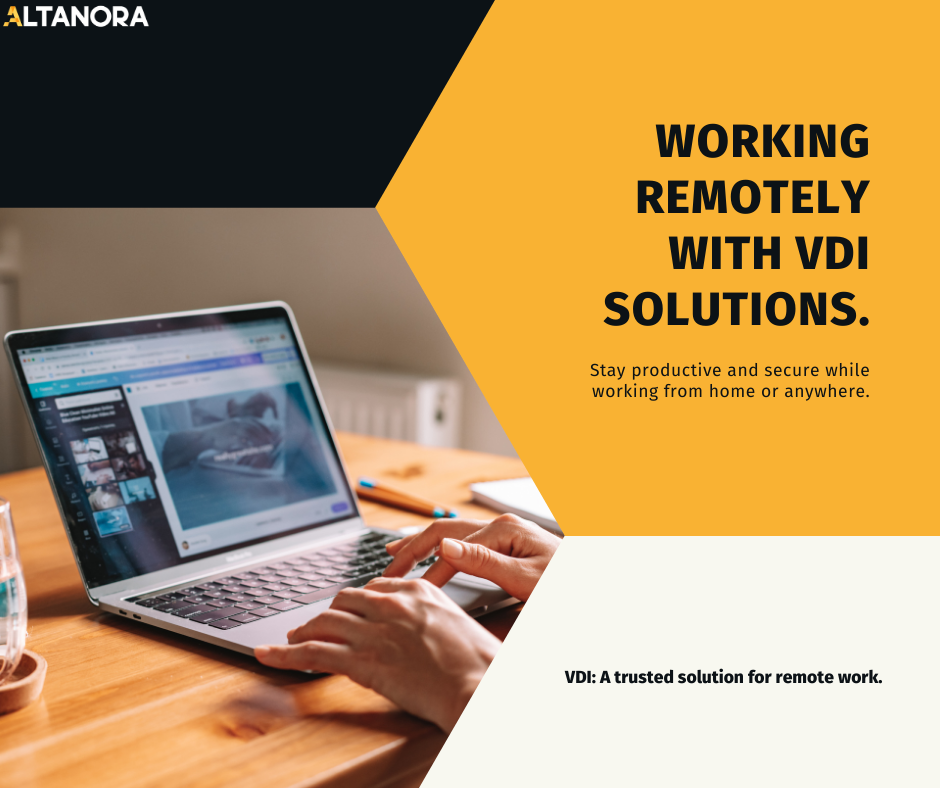 Navigating the Future of Remote Work: Selecting the Best VDI Solution
Navigating the Future of Remote Work: Selecting the Best VDI Solution
In the dynamic world of remote work technology, choosing the appropriate Virtual Desktop Infrastructure (VDI) solution is crucial. This guide, with insights from Altanora's expert assessments, examines four leading VDI solutions for 2024: Citrix DaaS/Universal, VMware Horizon, AWS WorkSpaces, and Microsoft Azure Virtual Desktop. We aim to provide businesses with in-depth analysis, helping them navigate options like best VDI solutions 2024, virtual desktop infrastructure comparison, and remote work technology advancements.
Key Takeaways:
- Citrix DaaS/Universal: Citrix DaaS, with its high-performance virtualization and cloud flexibility, is an excellent choice for organizations running desktop environments, as Altanora's assessments often highlight. Its integration with Citrix Application Delivery Controller (ADC) enhances its capabilities, making it versatile for various business environments.
- VMware Horizon: VMware Horizon provides a secure and efficient VDI environment, well-suited for businesses prioritizing security and integration, as noted in Altanora’s technical evaluations.
- AWS WorkSpaces: AWS WorkSpaces, identified by Altanora as a robust and scalable cloud desktop solution, excels in adapting to diverse business requirements and integrating with the AWS ecosystem.
- Microsoft Azure Virtual Desktop: Azure Virtual Desktop is renowned for its cloud integration and Windows Virtual Desktop features, often recommended by Altanora for businesses deeply integrated with Microsoft services.
Detailed Analysis of Each VDI Solution
Citrix DaaS/Universal Overview, Pros, and Cons
Overview:
The Citrix solution is ideal for businesses requiring high-end graphics virtualization and flexible deployment, access and collaboration options requiring high-availability and security protection against ransomware and the likes. It's particularly suitable for industries like healthcare, finance, manufacturing/development that incorporate design, architecture, and engineering, where 3D designs and CAD applications are prevalent.
Pros:
Comprehensive Deployment Options: Citrix DaaS/Universal offers unparalleled flexibility with on-premises, cloud, and hybrid deployment models. This adaptability is beneficial for businesses with varying infrastructure needs and those undergoing digital transformation.
Advanced Graphics and HDX Technology: Citrix excels in delivering high-quality graphics and virtualization, making it ideal for graphically intensive applications like 3D design, video editing, and CAD software. HDX technology ensures smooth performance even in bandwidth-limited scenarios.
Optimized User Experience: Citrix is dedicated to providing a seamless and responsive user experience. This is particularly crucial in scenarios requiring advanced graphics or detailed visualizations, ensuring that users have a consistent experience regardless of their device or location.
Cons:
Complex Licensing and Deployment: The licensing structure and deployment strategies of Citrix can be intricate and sometimes overwhelming. Businesses need to carefully evaluate their requirements to optimize costs effectively and may require expert guidance, such as from Altanora, to navigate these complexities.
High Resource Demands: Deployments involving advanced graphics or large-scale setups may demand robust hardware resources. This necessitates thorough infrastructure analysis and possibly significant investment in hardware to ensure optimal performance and resource utilization.
Learning Curve: The feature-rich environment of Citrix, while advantageous, can pose a steeper learning curve for administrators and end-users. Adequate training and onboarding are essential to leverage the full capabilities of the solution.
VMware Horizon Overview, Pros, and Cons
Overview:
VMware Horizon is ideal for Organizations deeply integrated into the VMware ecosystem who are looking for advanced security and a unified workspace. It's well-suited for sectors with stringent data protection requirements like healthcare, finance, and government.
Use Case: VMware Horizon excels in scenarios where there is a need for comprehensive security features, including micro-segmentation, and where consistent user experience across multiple devices and locations is vital.
Pros:
Unified Workspace Integration: VMware Horizon offers a seamless integration with the broader VMware ecosystem, providing a unified workspace experience. This integration simplifies management and enhances operational efficiency, particularly for businesses already invested in VMware's infrastructure.
Advanced Security Features: VMware Horizon is equipped with robust security features such as dynamic environment management, enhancing overall data protection. This is especially beneficial in sectors where data security and compliance are paramount.
Efficient Resource Utilization: VMware's resource management features, including intelligent load balancing and resource allocation, help optimize hardware usage. This contributes to enhanced performance and responsiveness, ensuring a more efficient VDI environment.
Cons:
Resource Overhead Challenges: Handling resource-intensive tasks may place significant demands on hardware resources. It's essential for businesses to plan their infrastructure meticulously, considering both current and future needs, to maintain optimal performance levels.
Licensing Complexities: VMware Horizon's advanced features may require additional licensing, which can have budgetary implications. Businesses need to understand the licensing structures thoroughly to align their investment with their usage and needs.
Dependency on VMware Ecosystem: While the integration within the VMware ecosystem offers numerous benefits, it can also create dependencies. This might pose challenges in environments that use a diverse range of technologies, requiring careful planning and potential additional investments in compatibility solutions.
AWS WorkSpaces Overview, Pros, and Cons
Overview:
AWS WorkSpaces is ideal for Companies seeking scalable and cost-effective cloud-based VDI solutions. This solution is particularly advantageous for startups and SMEs that require flexibility in their computing needs without heavy upfront investments.
Use Case: This solution is best for organizations that prefer a pay-as-you-go pricing model and those that need easy integration with the AWS ecosystem, such as businesses already leveraging other AWS services.
Pros:
High Degree of Flexibility and Scalability: AWS WorkSpaces offers a variety of bundle options, allowing businesses to choose the right mix of CPU, memory, and storage to meet their specific needs. This flexibility, coupled with the ability to scale up or down easily, makes it ideal for handling fluctuating workloads and changing business requirements.
Seamless AWS Ecosystem Integration: AWS WorkSpaces is designed to integrate effortlessly with other AWS services, like AWS Directory Service and Amazon S3. This integration enhances operational efficiency and provides a robust and secure cloud environment, leveraging the strength of the broader AWS ecosystem.
Cost-Effective Pricing Model: The pay-as-you-go pricing model of AWS WorkSpaces allows businesses to pay only for what they use, which can be particularly cost-effective for companies looking to manage their operational expenses effectively.
Cons:
Complex Pricing Structure: Despite its potential cost benefits, the pricing model of AWS WorkSpaces can be complex to understand, especially with various pricing components like bundle types and running mode options. Businesses might require detailed analysis to fully grasp the cost implications.
Network Reliance: Effective use of AWS WorkSpaces demands a stable and robust network connection. This reliance on network quality can be a limiting factor in regions with limited connectivity or in scenarios where consistent internet access is a challenge.
Limited Customization Options: Compared to other solutions like Citrix, AWS WorkSpaces might offer fewer customization options, particularly in terms of desktop experience and advanced configurations. This can be a consideration for businesses needing highly tailored VDI environments.
 Microsoft Azure Virtual Desktop Overview, Pros, and Cons
Microsoft Azure Virtual Desktop Overview, Pros, and Cons
Overview:
Azure is Ideal for Enterprises heavily invested in the Microsoft ecosystem, especially those utilizing Microsoft 365 and other Azure services. It's suitable for organizations needing global accessibility and scalable cloud infrastructure.
Use Case: Azure Virtual Desktop is optimal for businesses requiring scalability to handle varying workloads and those looking for a seamless integration with Microsoft services and applications.
Pros:
Scalability and Flexibility: Azure Virtual Desktop offers scalable solutions that are ideal for businesses with fluctuating or growing workloads. Its flexibility ensures that businesses can adjust their VDI environment as their needs evolve, providing optimal performance and responsiveness.
Integration with Microsoft Ecosystem: Seamless integration with Microsoft 365 and other Microsoft services ensures a cohesive user experience. This is particularly advantageous for organizations heavily invested in the Microsoft technology stack, as it allows for a more streamlined and efficient IT management.
Global Availability and Reliability: Leveraging Microsoft Azure's extensive global infrastructure, Azure Virtual Desktop provides reliable and low-latency access from various geographic locations. This global presence ensures that businesses can offer a consistent user experience to employees, regardless of their location.
Cons:
Cost Management Challenges: As usage grows, managing costs can become increasingly complex. Businesses need to continuously monitor and optimize their Azure Virtual Desktop environments to maintain cost-effectiveness and avoid unexpected expenses.
Customization Limitations: While Azure Virtual Desktop offers a range of configuration options, it may not provide the same level of granular customization as some of its competitors. Organizations with specific or advanced customization requirements may need to evaluate whether Azure can meet their needs.
Dependency on Microsoft Services: The integration with Microsoft services, while beneficial in many aspects, can also create a reliance on the Microsoft ecosystem. This could be a limiting factor for businesses seeking greater flexibility or those that use a diverse set of technologies and platforms.
Conclusion
Selecting the right VDI solution is a strategic decision that shapes your business's future in remote work technology. Whether it's Citrix's flexibility, VMware's security, AWS WorkSpaces' scalability, or Azure's integration with Microsoft, Altanora's assessment can guide you to the best choice. Contact Altanora for a tailored VDI solution assessment and take the first step towards an optimized, secure, and efficient virtual desktop environment.





